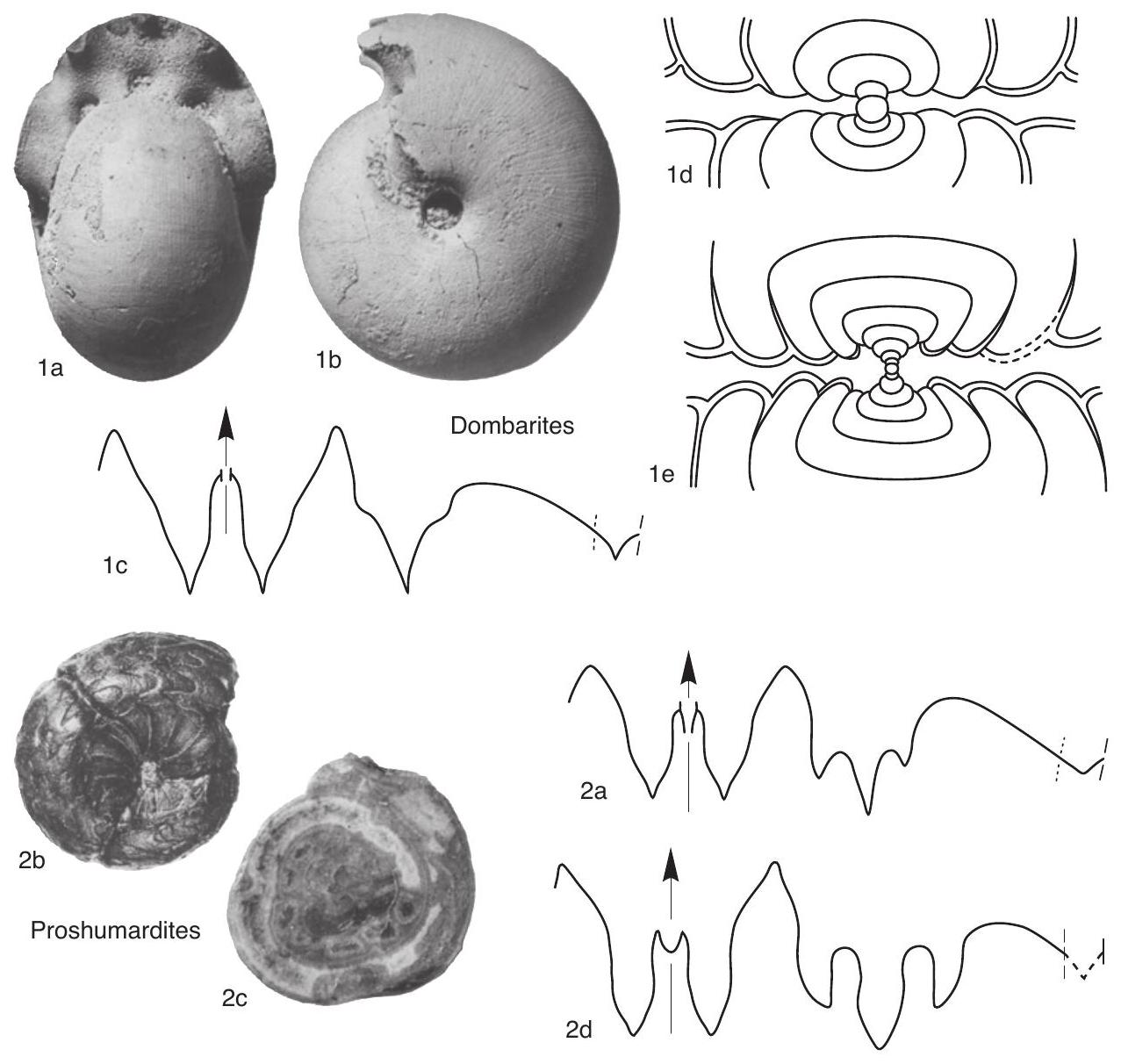Welcome to the Treatise on Invertebrate Paleontology!
Please enter a genera name to retrieve more information.

Dombarites
Classification
Phylum:
Mollusca
Class:
Cephalopoda
Subclass:
Ammonoidea
Order:
Goniatitida
Suborder:
Goniatitina
Superfamily:
Goniatitoidea
Family:
Delepinoceratidae
Subfamily:
Dombaritinae
Formal Genus Name and Reference:
Dombarites LIBROVICH, 1957, p. 257
Type Species:
D. tectus LIBROVICH, 1957, p. 258, OD
Images
(Click to enlarge in a new window)
F i G . 35,1a–c. *D. tectus; a–b, Dombar Hills, South Urals, Kazakhstan, lower Serpukhovian, PIN 455/19456, × 1; c, suture, whorl height at 31 mm, whorl width 41.5 mm, PIN 455/19455, × 1.1 (Ruzhentsev & Bogoslovskaia, 1970).——FiG. 35,1d–e. D. choctawensis (shumard), Johnston County, Oklahoma, Caney Shale, upper Chesterian; d, cross section showing subspherical early whorls, USNM 119502, × 5; e, cross section showing subquadrate early whorls, USNM 119504, ×5 (Gordon, 1965).
Synonyms
Revillocera
Geographic Distribution
Oklahoma, Texas, Utah, Nevada
Age Range
Beginning Stage in Treatise Usage:
Mississippian (lower Serpukhovian)
Beginning International Stage:
Serpukhovian
Fraction Up In Beginning Stage:
0
Beginning Date:
330.34
Ending Stage in Treatise Usage:
Mississippian (lower Serpukhovian)
Ending International Stage:
Serpukhovian
Fraction Up In Ending Stage:
50
Ending Date:
326.87
Description
Conch form in general similar to Lusitanoceras, but adventitious lobe with short processes on both sides with tendency to become tridentate, Several species with triangular whorls on immature stages, some species with oxycone venter on adult stages, Ornamentation usually with closely spaced lirae, some species lacking spiral ornamentation, Ventral lobe relatively wide, median saddle about half as high or higher, in some species reaching two-thirds height of entire ventral lobe, Sides of ventral lobe diverging, less in apicad part, strongly in orad part, inflexion point coinciding usually with height of median saddle, First lateral saddle acute or subacute
References
Museum or Author Information
Classification
Phylum:
Mollusca
Class:
Cephalopoda
Subclass:
Ammonoidea
Order:
Goniatitida
Suborder:
Goniatitina
Superfamily:
Goniatitoidea
Family:
Delepinoceratidae
Subfamily:
Dombaritinae
Formal Genus Name and Reference:
Dombarites LIBROVICH, 1957, p. 257
Type Species:
D. tectus LIBROVICH, 1957, p. 258, OD
Images
(Click to enlarge in a new window)
F i G . 35,1a–c. *D. tectus; a–b, Dombar Hills, South Urals, Kazakhstan, lower Serpukhovian, PIN 455/19456, × 1; c, suture, whorl height at 31 mm, whorl width 41.5 mm, PIN 455/19455, × 1.1 (Ruzhentsev & Bogoslovskaia, 1970).——FiG. 35,1d–e. D. choctawensis (shumard), Johnston County, Oklahoma, Caney Shale, upper Chesterian; d, cross section showing subspherical early whorls, USNM 119502, × 5; e, cross section showing subquadrate early whorls, USNM 119504, ×5 (Gordon, 1965).
Synonyms
Revillocera
Geographic Distribution
Oklahoma, Texas, Utah, Nevada
Age Range
Beginning Stage in Treatise Usage:
Mississippian (lower Serpukhovian)
Beginning International Stage:
Serpukhovian
Fraction Up In Beginning Stage:
0
Beginning Date:
330.34
Ending Stage in Treatise Usage:
Mississippian (lower Serpukhovian)
Ending International Stage:
Serpukhovian
Fraction Up In Ending Stage:
50
Ending Date:
326.87
Description
Conch form in general similar to Lusitanoceras, but adventitious lobe with short processes on both sides with tendency to become tridentate, Several species with triangular whorls on immature stages, some species with oxycone venter on adult stages, Ornamentation usually with closely spaced lirae, some species lacking spiral ornamentation, Ventral lobe relatively wide, median saddle about half as high or higher, in some species reaching two-thirds height of entire ventral lobe, Sides of ventral lobe diverging, less in apicad part, strongly in orad part, inflexion point coinciding usually with height of median saddle, First lateral saddle acute or subacute
